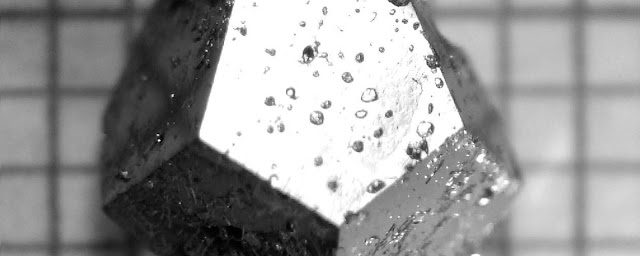Did asteroid crash cause Earth?s rarest structure?
 |
| A lab made quasicrystal. |
The rarest crystals on Earth: Scientists reveal only two quasicrystals have EVER been found – and they were caused by colliding asteroids
Naturally formed quasicrystals?crystal-like solids with supposedly impossible symmetries?are among the rarest structures on Earth. Only two have ever been found.
Scientists have only found two quasicrystals on Earth. These super rare crystal-like solids have supposedly impossible symmetries. New experiments could explain why they?re so rare: Collisions between asteroids may have caused them.
Paul Asimow, professor of geology and geochemistry at Caltech, tested this idea by the collision between two asteroids in his lab.
He took thin slices of minerals found in the Khatyrka meteorite?the original source of the only known quasicrystals?and sandwiched them together in a sample case that resembles a steel hockey puck.
He then screwed the ?puck? to the muzzle of a four-meter-long, 20-mm-bore single-stage propellant gun, and blasted it with a projectile at nearly one kilometer per second, about equal to the speed of the fastest rifle-fired bullets.
It is important to note that those minerals included a sample of a metallic copper-aluminum alloy, which has only been found in nature in the Khatyrka meteorite, an extraterrestrial object known only from a few pieces found in Russia?s Koryak Mountains.
After the sample was shocked with the propellant gun, it was sawed open, polished, and examined. The impact smashed the sandwiched elements together and, in several spots, created microscopic quasicrystals.
Armed with this experimental evidence, Asimow says he is confident that shocks are the source of naturally formed quasicrystals.
?We know that the Khatyrka meteorite was shocked. And now we know that when you shock the starting materials that were available in that meteorite, you get a quasicrystal.?
?Nature is crazy?
Sarah Stewart?a planetary collision expert from the University of California, Davis, and reviewer of the PNAS paper?admits she was surprised by the findings. ?If you had called me before the study and asked if this would work I would have said ?no way.? The astounding thing is that they did it so easily,? she says. ?Nature is crazy.?
Asimow acknowledges that the experiments leave many questions unanswered. For example, it is unclear at what point the quasicrystal formed during the shock?s pressure and temperature cycle. A bigger mystery, Asimow says, is the origin of the copper-aluminum alloy in the meteorite, which has never been seen elsewhere in nature.
Next, Asimow plans to shock various combinations of minerals to see what key ingredients are necessary for natural quasicrystal formation.
Why the crystals are so unusual
At an atomic level, crystals are both ordered and periodic, meaning that they have a defined geometric structure, with that structure repeating itself over and over. To grow such a repeating structure without the original organization breaking down, the crystal can only exhibit one of four types of rotational symmetry: two-fold, three-fold, four-fold, or six-fold.
The number refers to how many times an object will look exactly the same within a full 360-degree rotation about an axis. For example, an object with two-fold symmetry appears the same twice, or every 180 degrees; an object with three-fold symmetry appears the same three times, or every 120 degrees; and an object with four-fold symmetry appears the same four times, or every 90 degrees.
Prior to 1984, scientists believed that it would be impossible for a crystal to grow with any other type of symmetry; no examples of crystals with other symmetries had been discovered in nature or grown in a lab. In that year, however, Princeton physicist Paul Steinhardt theorized a set of conditions under which other types of symmetry could potentially exist and Dan Shechtman of the Israel Institute of Technology published a paper announcing the creation of a crystal-like structure with a five-fold rotational symmetry.
These structures were ordered enough to produce recognizable diffraction patterns when shot with high-energy beams of electrons and X-rays?unlike disordered structures, which produce no patterns. However, the crystal-like structures were not periodic?that is, their organization shifted and changed as they grew. The materials were dubbed ?quasiperiodic crystals,? or ?quasicrystals? for short.
The Khatyrka meteorite
 |
| The electron backscatter diffraction pattern of the quasicrystal reveals its unusual structure. (Credit: Asimow Laboratory/Caltech) |
Over the next few decades, researchers figured out how to manufacture more than 100 different varieties of quasicrystals by melting and homogenizing certain elements and then cooling them at very specific rates in the lab.
Still, though, no naturally existing quasicrystals were known. Indeed, researchers suspected their formation would be impossible. That is because most lab-grown quasicrystals were metastable, meaning that the same combination of elements could arrange themselves into a crystalline structure using less energy.
Everything changed in the late 2000s, when Steinhardt and colleague Luca Bindi from the Museum of Natural History at the University of Florence found a tiny grain of an aluminum, copper, and iron mineral that exhibited five-fold symmetry. The grain came from a small sample of the Khatyrka meteorite. Steinhardt and his collaborators found a second natural quasicrystal from the same meteorite in 2015, confirming that the natural existence of quasicrystals was possible, just very rare.
A microscopic analysis of the meteorite indicated that it had undergone a major shock at some point in its lifetime before crashing to Earth?likely from a collision with another rocky body in space. Such collisions are common in the asteroid belt and release high amounts of energy.
Asimow and colleagues hypothesized that the energy released by the shock could have caused the quasicrystal?s formation by triggering a rapid cycle of compression, heating, decompression, and cooling.
Researchers from Princeton University and the University of Nevada, Las Vegas collaborated on the project, which was supported by the National Science Foundation and the University of Florence.
A paper on their findings was published in the Proceedings of the National Academy of Sciences.
This article was written by